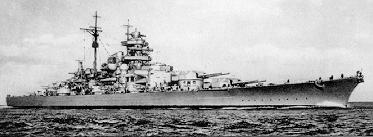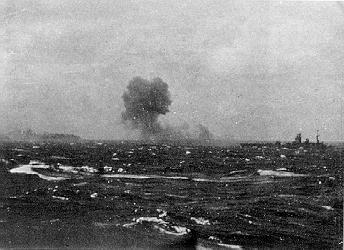 |
 |
 |
| Home | Clifford Woolley | Specifications | History | Photographs | Drawings/Models | Crew Listing | Books | Contact Us |
|
Germany's greatest Battleship was commissioned in August 1940. She was 820 feet long, 118 feet wide with a displacement of 44,734 tons (48,626 when fully loaded). This was in excess of the Anglo-German Treaty in which a limit of 35,000 was agreed. It was designed for a minimum draft of 33 feet and a top speed of approximately 30 knots. The 8 15-inch guns mounted on 4 twin turrets were the biggest to be mounted on any German warship. The heavily armoured turrets (5 to 14 inches) were named Anton, Bruno, Caesar and Dora. Germany's Admiral Tirpitz described the ship as 'an unsinkable gun platform'. On September 15, 1940 Bismarck left Hamburg's Blohm and Voss shipyard for the eastern Baltic in order to be safe from British air attacks. In early March the Bismarck along with the heavy cruiser Prinz Eugen were in the Gulf of Danzig for sea trials and battle practice. On May 19, 1941 the ship and Prinz Eugen departed with 2,206 men on board for their first mission - Operation Exercise Rhine. At 1:15pm on May 21, the Bismarck was spotted by British aerial reconnaissance. Upon receiving this news Admiral John Tovey dispatched numerous ships to the area to enagage the Bismarck. Early on the morning of Thursday May 22, Bismarck and Prinz Eugen left their escorts for the coast of Norway. At noon the next day, both ships were sailing due north of Iceland, and were nearing the Denmark Strait. The HMS Hood was on a converging course 300 miles south and would be within range early the next morning. At 5:52am May 23, the battle began with a salvo from the HMS Hood. After numerous errant shells were exchanged, a salvo from the Bismarck hit penetrated the deck armor and touched off the 15 inch ammunition store. The resulting explosion snapped the ship in two. Huge fireballs and thick heavy black smoke were bellowing from the ship. Within 6 minutes of the first shell, the HMS Hood was lost. Only 3 crew members survived the explosion. With the battle crusier HMS Repulse, aircraft carrier HMS Victorious, the flagship King George V, four cruisers and nine destroyers en route to find the Bismarck, the HMS Rodney was commanded to join the search. The HMS Rodney along with four destroyers, was escorting the troop ship Britannic to Halifax. The ship was then to continue to Boston for a long overdue refit. Shortly after receiving the tragic news of the Hood, they received the signal to engage the Bismarck. "Enemy's position 62, 25' N., 33, 00'W., course 210, speed 26 at 0900/24. Steer best closing course. If Britannic can't keep up let her proceed alone with one destroyer". About 2pm on May 24 the HMS Rodney turned north to join the pursuit. The Prinz Eugen left the company of the Bismarck and proceeded on southward course. During the evening of May 24, a Swordfish bi-plane scored a hit. The torpedo had caused little damage, but trying to evade the attackers had caused the collision mats protecting the shell holes to come loose. Water was pouring in causing the bow of the ship to go down lower and lower. May 25 the Bismarck didn't come into contact with any enemy ships at all. This provided them time for repairs and rest. The British fleet was closing in on the ship. At 9:00pm the HMS Rodney which has been sailing northeast all day, altered her course to the east to intersect the Bismarck's probable course. At 10:30am on May 26 a Catalina flying boat spotted the Bismarck. The position approximately 700 miles from Brest was relayed to the entire British fleet.The HMS Rodney was about 125 miles to the northeast. The King George V was 135 miles to the north. Fifteen Swordfish bi-planes were dispatched from the carrier Ark Royal in order to slow the Bismarck. All fifteen planes were able to launch their torpedos. One of them hit the starboard quarter disabling the Bismarck's steering mechanism and jamming the rudders. All the ship could do was to travel in large circles. The HMS Rodney and King George V were closing in on the crippled Bismarck. At 7:37am on May 27 the Bismarck was 21 miles away from the 2 British battleships. The HMS Rodney fired the first salvo at 8:47am. Then the King George V sent off shells of their own. Shortly after orange flashes could be seen coming from the Bismarck's two forward turrets. The response fell one thousand yards short. The Germans were directing their fire at the older HMS Rodney. They continued to exchange fire. Bismarck's third salvo straddled HMS Rodney, but only shell splinters hit the ship, damaging the antiaircraft director, but causing no casulties. Now joined by the Dorsetshire and Norfolk the battle continued. At 8:59am one of the shells from HMS Rodney's 16 inch guns exploded near Anton and Bruno, knocking them both out of action. The ships continued to close in on the battered and burning Bismarck. At 9:15am the HMS Rodney and King George V were about 2.5 miles away. They were close enough to bring their secondary armament to bear. Both ships continued to fire at the Bismarck. In all 2,876 shells were fired with 719 from the big guns alone. Because the trajectory was so low, many of the hits were above the waterline. The Bismarck was a blazing wreck, but would not sink. At 10:15am both British ships withdrew.
The order was given aboard the Bismarck to scuttle the ship. At about the same time the Dorsetshire came in close to fire torpedos at 10:36am. At 10:39 the Bismarck sinks and the Dorsetshire stayed behind to pick up survivors. It's unknown if the ship sunk because of the torpedo or the delibrate attempt to scuttle her. |

